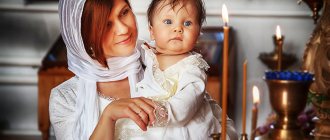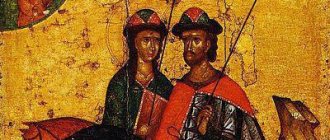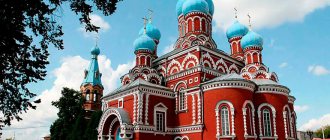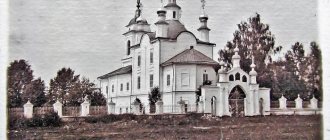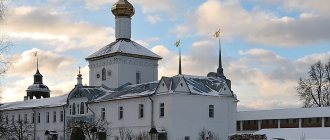Unmercenary and miracle workers Cosmas and Damian of Asia, and their mother the Venerable Theodotia
Lives of the unmercenary and miracle workers Cosmas and Damian of Asia and their mother the Venerable Theodotia
The unmercenary saints Cosmas and Damian were brothers.
Their homeland is Asia. This is how part of Asia Minor was called in ancient times. Neither their time of birth nor their time of death is known. What is certain is that they lived no later than the 4th century. One must think this way, firstly, because in the first half of the 5th century, under Emperor Theodosius the Younger, holy temples were built in their name, and secondly, because the Copts, who separated from Orthodoxy since the Council of Chalcedon (431) , recognize them as saints, while they do not accept saints who lived after this time. Their father was a Greek and a pagan, their mother was a Christian, named Theodotia. In their early years they lost their parent, but this served to their happiness. The mother could be more free to raise her children. Deciding to remain a widow for the rest of her life, she zealously fulfilled the Christian law; having given up all the joys of life, she only cared about it in order to please the Lord. In a word, she was a true widow, such as the Apostle Paul praises: a true widow is solitary, trusts in God and remains in prayer and supplication day and night (1 Tim. 5:5).
Therefore, the Holy Church canonized her, named her venerable, and commemorates her together with her children. One can understand what kind of upbringing the children received under the guidance of such a mother. From infancy, she tried to instill in them the fear of God and love of virtue. And as soon as the children began to grow up, she sent them to a certain God-fearing husband to learn to read and write. Here, of course, the main science was the Divine Scripture, but at the same time, driven by love for suffering humanity, they studied medical science and learned the healing properties of herbs and plants.
The Lord blessed their good intentions and gave them special grace - the gift of healings and miracles. The illnesses stopped as soon as Cosmas and Damian began to treat. This, of course, attracted many sick people of all kinds to them.
The blind, the lame, the paralytic, and the possessed surrounded the miracle workers. But the saints were not burdened by this. Not only to be more accessible to the sick, they themselves looked for them and for this they moved from city to city, from city to city, and to all the sick, without distinction of gender and age, rank and condition, they gave healing.
And they did this not in order to get rich or become famous, but with the purest, highest goal - to serve the suffering for the sake of God, to express love for God in love for their neighbors. Therefore, they never accepted any reward from anyone for their labors, not even any signs of gratitude for their own good deeds. They firmly knew and faithfully kept the commandment of the Savior: heal the sick, cleanse the lepers, raise the dead, cast out demons: eat tuna, give tuna (Matthew 10:8).
They received grace from God freely, and freely distributed it. They asked only one thing of those healed by them: that they firmly believe in Christ, live holy in Christ; if those being healed were not yet enlightened by the light of the Gospel, then they tried to convert them to the Christian faith. Thus, while healing physical ailments, they at the same time healed mental ailments.
For this selfless service to suffering humanity, for these miraculous healings of incurable diseases, the Holy Church calls them unmercenary and miracle workers.
But the healing power of the holy doctors did not extend only to people. They did not forget dumb animals. The righteous has mercy on the souls of cattle, speaking the word of God (Prov. 12:10). Faithful to this commandment, they walked through houses, deserts and forests, themselves looking for sick animals and giving them healing. Grateful animals felt their benefits, knew their benefactors, and, as soon as these appeared in the deserts, followed them in whole herds.
One day they happened to go into a deserted place. Here they found a barely alive camel. The devil drove him here and broke him here; The saints took pity on the animal, healed it and released it healthy to its place. Afterwards, as we will see, the animal did not remain ungrateful to them.
The entire life of the unmercenary saints was spent in such works of mercy. The brothers never parted with each other; they prayed together, walked together, and healed together. And they did this with a purpose. Having vowed never to take anything from anyone, they were afraid that someone would secretly take any gifts from the healed people from each other. All their lives they kept their vow, and only at the end of it did the Lord allow one of them to break it.
In those days there was a certain wife named Palladia. Having suffered from a serious illness for several years, not receiving relief from any doctors, already feeling the approach of death, she suddenly heard about holy doctors who heal all sorts of diseases.
With faith in their miraculous power, she sent them to her to ask. The saints fulfilled her request, and as soon as they entered her house, the sick woman received healing and stood up completely healthy. In gratitude for the healing, she was ready to give them all her property and offered rich gifts, but the saints did not accept anything.
Then she came up with a means of begging at least one of them to accept an insignificant gift from her. Taking three eggs, she secretly came to Saint Damian and conjured him in the name of God to take these three eggs from her in the name of the Holy Trinity. Damian refused for a long time, but for the sake of his wife’s oath, for the sake of the name of God, he gave in to her request.
Cosmas found out about this, was very upset, and then made a will so that after their death, Damian’s body would not be laid with him, as someone who had broken his vow to the Lord and had taken a bribe for healing. That same night the Lord appeared to Cosmas and said: “Why are you grieving for the sake of the three eggs you took? They were taken not for the sake of a bribe, but for the sake of the wife’s oath in My name...” Cosmas was comforted, but did not tell anyone about his vision. After this, having performed many more signs and wonders, Saint Cosmas rested in peace.
Some time after his death, Saint Damian also rested in peace. People who honored their memory surrounded Damian's body and wondered where to put it. Everyone had Cosma’s will fresh in their minds, and they were afraid to break it.
And so, when they stood in bewilderment at the holy body, a camel suddenly approached them. The people were silent, the camel spoke. “Men of God,” the wordless man began his speech, “who have enjoyed many signs and wonders from Saints Cosmas and Damian, and not only you, but also we, the animals given to you by God. As a servant, I came to you to tell you the secret of Cosmas, so as not to separate them from each other, but to put them together.”
This camel was the same one that had once been healed by the saints. The people who surrounded the body of the saint thanked the Lord, who had so miraculously revealed His secret, and, placing the holy relics of the unmercenaries in one coffin, buried them in a place called Fereman (now does not exist, destroyed by the Turks). Judging by the descriptions of the originals, they died in middle age.
Soon, at the site of their burial, a wonderful and glorious church was built, as their biography says. All kinds of sick people flocked to this church from near and far countries.
Seeing such endless and inexhaustible wealth of the saints, the sick constantly surrounded their temple. After this, one can judge how many miracles were performed by the holy unmercenaries. It is not for nothing that their biographer says that it is easier to measure the sea and count the stars than to tell all the miracles of the saints. Of the many miracles, he described twelve, and in some detail. Dimitri, Metropolitan Rostovsky, in his Menaions, described only two miracles. We will briefly talk about six of the twelve.
A certain Malchus lived in Pheremane. One day, setting off on a long journey, he brought his wife to the church of the holy unmercenaries and said to her: “Behold, I am going far away, and I am leaving you under the protection of Saints Cosmas and Damian. Live at home until I send you some sign that you will know for sure that it is mine.” Having said this, they parted.
After some time, the devil, taking on the appearance of a familiar person, came to Malkhova’s wife, showed her the very sign that her husband had spoken about, and said: “Your husband sent me to take you to him.”
The wife, seeing the sign given by her husband, believed, but decided to go to him not before the guide took an oath in the Church of the Holy Unmercenaries on the way not to offend her in any way. But what did the oath mean to the demon? He needed to weaken people's faith in the protection of the unmercenary saints.
And so, as soon as they arrived in a wild, deserted place, the devil pushed the woman off the donkey on which she was riding and wanted to kill her. The wife cried out in horror: “Saints Cosmo and Damian, help me and deliver me!”
Saints are always close to everyone who calls them. Suddenly two horsemen appeared. The evil spirit found out who these riders were, ran up a high mountain, threw himself into the abyss and disappeared. And the horsemen, taking the wife, returned her safely to her house. The wife bowed to them and thanked them, but only asked them to tell them who they were, her saviors? “We,” the saints answered, “Cosmas and Damian, to whom your husband entrusted you when he set out on his journey.” Having said this, they became invisible. The wife fell to the ground out of fear and joy.
Having come to her senses, she hurried to the temple of the holy unmercenaries and there she tearfully thanked them and told everyone about her salvation.
A certain young man, having lost his mind from fright, was brought to the temple of the holy unmercenaries with the hope of receiving healing. He spent several days and nights at the church of saints without receiving healing.
After some time, his father, a pious elder, came to him. The parent's prayer was heard. The son, who had not previously recognized his father, began to recognize him. Finally, the saints, invisibly laying their hands on him, completely healed him and, appearing to his father, commanded him to go to his home, glorifying God.
A certain man, suffering from a lung disease accompanied by hemoptysis, came to the relics of the unmercenary saints to ask for healing. His illness was so dangerous that everyone considered him close to death, and his wife even prepared everything necessary for burial. It should be noted that the patient had not previously believed in the miraculous power of the saints and often spewed blasphemy against God.
The saints healed him of both ailments. In a night vision, they proclaimed that anyone seeking healing should never speak blasphemous words from now on and should abstain from eating meat for a whole year. The patient gladly accepted that offer and faithfully fulfilled it. Then, by the command of the saints, the blood flowing through the larynx stopped, the lungs became stronger, and the patient, thanking the wonderful doctors, joyfully went to his home.
A certain mute and deaf woman came to the Church of the Holy Unmercenaries. Having suffered from this serious illness for many years, she could not expect any help for herself other than heavenly help. For a long time, persistently, with tears, she prayed to the holy doctors to heal her from both ailments. Finally, her prayer was heard. The mute and deaf woman often repeated the Trisagion in her mind. Through the Trisagion, the holy unmercenaries also showed a miracle.
During the evening service in their church, when, according to custom, the Trisagion was sung, suddenly the deaf woman heard the singers and, hitherto mute, began to sing the Trisagion with the singers. Struck by the extraordinary miracle, she loudly confessed the greatness of God revealed through the holy unmercenaries.
Unmercenary saints performed miracles in pagan countries. It happened to one Hellene, a fan of Castor and Pollux (pagan gods), to fall into a serious, unbearable illness. His friends advised him to go to the temple of the unmercenary saints Cosmas and Damian. The patient obeyed. Here, seeing many sick people, many being healed, he finally became convinced of the miraculous power of doctors and with faith began to ask them for mercy.
The saints, both appearing to him together, said: “Friend! Why did you come to us? Why are you asking us? And you didn’t come to us yourself, but were sent by others. We are not Castor and Pollux, but slaves of Christ - the immortal King, named Cosmas and Damian. So, if by faith you know our Master, you will receive healing from Him.”
Hellin, suffering intolerable torment, came to know the True God, constantly cried out to the saints for mercy and vowed to accept the Christian faith. The saints, seeing the purity of his faith, laid their hands on him and gave him perfect deliverance. The one who was healed fulfilled his vow - he received Holy Baptism. Returning to his home completely healthy, he with great joy told everyone about the miracles of the holy unmercenaries, about the insignificance of Castor and Pollux, about the superiority of Christian teaching. Many of the listeners were moved and, despising their faith, accepted Christianity.
Someone - a lover of folk spectacles - suffered from a chest disease. Finding no relief in anything, he was finally forced to go to the temple of the holy unmercenaries. The holy doctors, seeing his zeal, had mercy on the patient.
The very next night they appeared to him and ordered him to drink one cup of resin (pekla). The patient did not fulfill their orders. The saints appeared to him a second time and added another to one cup. When he did not do this either, they appeared to him a third time and ordered him to drink three cups.
Despite the illness that increased in him every day, he did not want to fulfill the commandments of the saints. Finally, they appeared to him again in a dream and with cheerful faces said: “Friend, why are you crying out to us like that? If it is unpleasant for your health to drink three bowls of resin, then pour them into one vessel and, waiting until late evening, go up the mountain with it, to the place of spectacles, and bury it there so that no one can see you. If you do this, you will receive healing.”
The patient happily did everything as ordered. But everything he did was seen by one person who was late in that place. Explaining his strange act by sorcery, he, noticing the place, went and brought with him many other people. Those, having ascertained the truth of the testimony, took and presented the imaginary sorcerer to the court. They began to interrogate. He told the whole truth - they didn’t believe him.
Finally, they decided that if this really was the command of the holy unmercenaries, then in the sight of everyone he should drink these three cups and receive healing. The sick man joyfully accepted the vessel, which seemed unpleasant to him, drank it in front of everyone, and immediately received healing through the power of the holy unmercenaries; He joyfully went to their temple and, having given thanks, told everyone how the holy unmercenaries had healed him of his illness, taught him obedience, and weaned him off folk spectacles.
All these miracles were performed by the holy unmercenaries in Asia, and for the most part in their temple, with the holy relics. Of course, a description of them was also compiled there. It was translated into the Slavic language from Greek, as evidenced by many words left untranslated in the Slavic text. There is no doubt that the grace of the miracles of the holy unmercenaries was manifested in our Fatherland. It is not for nothing that our ancestors erected so many holy temples in their name.
In our Fatherland, the unmercenary saints Cosmas and Damian (Asian) are mainly considered the patrons of children. They are resorted to in prayer at the beginning of learning to read and write, so that they strengthen the children’s still weak strength and contribute to their correct development.
Of course, it was not without reason that our people developed such a belief. The basis for it could be partly their life itself, partly their church service: firstly, in their life there is a legend about how they were taken by their mother to learn to read and write. This incident from their lives is also depicted on icons; secondly, in church services they are glorified as wise doctors, secretly taught picturesque words, filled with all intelligence and wisdom, who give knowledge to everyone.
In the Menaion Menaions of Metropolitan Macarius there is a sermon in memory of the unmercenary saints Cosmas and Damian (November 1), in which the theme is chosen from the daily Gospel: “What a teacher should be.” In its development there are such expressions: “The holy teachers healed the body with miracles, the soul with teaching. They come to them for miracles, and they come for teaching. Nothing else is more appropriate for a teacher than humility and non-acquisitiveness.” All this comes so close to the unmercenary saints. Of course, in ancient times this teaching was read in the temple. The people heard him and began to come to the holy unmercenaries not only “for the sake of miracles, but also for the sake of teaching.”
The Orthodox people, seeing on the icons, reading in their lives the legend about teaching them to read and write, hearing in churches that they give knowledge to everyone, could not help but come to the conclusion that they especially patronize students. And the grace of the holy unmercenaries is endless, as the Holy Church sings. They are not only wise doctors, but also wise mentors; Having helped everyone who comes to them in faith, can they refuse the children?
Finishing the description of the life of the holy unmercenaries like Asia, one cannot fail to mention the word of praise for them, which in ancient lists was placed after the description of their lives, and which, of course, was read in their memory during divine services. Its origin, as scientists think, is Russian, because at the end it mentions the orthodox prince. After an ornate introduction, it contains praise or magnification of the unmercenary saints, presented in the form of an akathist, and at the end a prayerful appeal is made to them.
See also: “ The Life and Miracles of the Holy Unmercenaries and Wonderworkers Cosmas and Damian” as presented by St. Demetrius of Rostov.
Notes
[1] Asia, otherwise Asia - this name was used in ancient times not in the same sense. Initially it meant a small, abundantly watered, marshy plain in Lydia, i.e. in the middle of the western part of the present Asia Minor Peninsula, on the eastern shore of the Aegean Sea. The Romans divided the said peninsula into two approximately equal parts: one, the northeastern one, lying near the Black Sea, was called Pontus, the other, the southwestern one, was called Asia proper; each part was divided into several (not always the same number) provinces; upon the establishment of Christianity, each of the latter was, in turn, divided, in ecclesiastical terms, into several bishoprics (the Apocalypse also mentions 7 Asian churches - Rev. 1:4, 11). Over time, the name Asia began to be applied to the entire present-day Asia Minor Peninsula, and finally to the entire part of the world lying to the east of our Europe, on the same continent.
[2] The word “tune” means freely, without payment.
[3] Fereman was in Mesopotamia two days' journey from Amid (called Diar Beqir in Turkish, on the upper reaches of the Tigris River) and was destroyed by the Turks during their first conquests; at the same time the relics of St. Cosmas and Damian were transferred to Amid, where they rest to this day.
[4] Here we mean three Jewish youths - Ananias, Azariah and Mishael. While in Babylonian captivity, they refused to worship the golden image built by Nebuchadnezzar; for this, by order of the king, they were thrown into a very hot oven, but miraculously, by the grace of God, they remained unharmed in it, even with all their clothes (Dan. 3)
[5] Here, probably, of course, St. Equal to the Apostles Thekla. Her memory is celebrated on September 24.
Faces of saints
The most common icon of the unmercenaries Cosmas and Damian is the one on which the martyrs are painted together in full height, and the brothers are also depicted in motion. In the icon, Saints Cosmas and Damian are depicted dressed in long shirts, with capes made of a rectangular piece of fabric over them. The men hold a spoon in their right hand and a casket in their left; these objects indicate the men’s occupation—healing.
In addition to the traditional icon, there are also other images:
- icon of Cosmas and Damian of Arabia;
- brothers stand before God;
- saints sometimes heal the sick;
- fragments of their lives.
What do Cosmas and Damian pray for?
The brothers were doctors during their lifetime and are now revered as healers. The prayer to the saints is read during various illnesses: colds, chronic diseases, tumors, ulcers. Prayer to healers will help you get rid of drug and alcohol addiction.
The prayer addressed to Kosma and Demian has great power, so its reading should be taken seriously and only with pure thoughts.
Saints help all people who turn to them, protect them and support them. Since the brothers led a chaste and righteous lifestyle, they often help with discord in the family and protect against betrayal.
The Holy Face also helps to preserve the health of livestock, create strong marriage bonds, get rid of sorrows, free the soul from despondency, and protect against sudden death and illness.
What were the ancient doctors like?
Image: berdnik-stiv.livejournal.com
Only a person who had received a special medical education could become a doctor in the Byzantine Empire. To do this, it was necessary to graduate from medical school (the study of medicine was based on the works of the Greek physician Hippocrates and the ancient Roman Galen). Those who successfully passed the exams received a certificate of professional qualification as a doctor.
A doctor in those days was a man of status. Doctors could practice privately and become house doctors for wealthy families.
There was even a kind of ambulance - traveling doctors who helped those who could not get to hospitals on their own.
There was a position of the chief city doctor - “archiatr”.
Byzantine legislation even established criminal liability for doctors' mistakes. The forensic medical commission decided whether the doctor was guilty or not guilty. The punishment could be either a small fine or complete confiscation of property.
If a doctor committed an immoral act, he was taken around the city with a urine collection container in his hands for the sake of shame. And it happened that a doctor was sentenced to death: he was stabbed to death with a sword.
Hospitals in ancient times
“Emperor John II of Byzantium founded the monastery of the Pantocrator in Constantinople, the complex of which included a hospital, which became the largest medical center of that time.”
Photo from the site panoramio.com In the ancient world, hospitals as such did not exist. The first medical institutions in our understanding appeared precisely at Christian monasteries. For example, one of the first and best was the hospital at the monastery founded by Bishop Basil the Great, a famous theologian (IV), in the city of Caesarea. Outwardly, it was very reminiscent of modern hospital complexes: it included as many buildings as were known in those days of illness.
The monastic charter provided for, in addition to the hospitals themselves, the construction of almshouses and xenodochias at the monasteries - inns for travelers who fell ill on the road. The hospital town, built by St. Basil the Great and called “Refuge,” included, in addition to hospital buildings, hotels for nonresidents, a leper colony, and a shelter for the poor.
People in monastery hospitals were treated free of charge, or for a feasible donation.
Later, private and public hospitals began to appear, the pharmacy business began to develop, and medical schools arose at hospitals. Emperor John II of Byzantium founded the monastery of the Pantocrator in Constantinople, the complex of which included a hospital, which became the largest medical center of that time.
The surviving monastic charter gives us a complete picture of the work of this complex: five halls with 50 beds each, departments of surgery, ophthalmology, gastroenterology, gynecology, and two more departments for other diseases. There was a pharmacy.
The bed was a bed with a mattress and goat's hair blankets. Water supply and sewerage worked, and heaters in winter. A bathroom has been installed. The patients were provided with clothing, mattresses and blankets were updated annually.
The charter also determined the remuneration of employees. The emperor was generous, but doctors working in the monastery hospital were prohibited from private practice.
Temples dedicated to saints
In many cities of Russia and other countries, many churches have been built in honor of the martyrs Cosmas and Damian, in which people can turn to saints for help, read prayers to them and glorify both their gift and virtue.
List of temples:
- · “Church of Cosmas and Damian of Rome, in Starye Panekh. It was built in 1564, rebuilt and restored in 1803 in
- classicism style. It was destroyed in 1930, but restored in 2000 to its supposed original form.
- · The Temple of Cosmas and Damian in Shubin, was built in 1722, in a simplified Moscow Baroque style.
- · Temple of Cosmas and Damian, located in the village of Brusyany, Samara region.
- · Monastery of the Holy Brothers in Serbia, 5 km east of Orahovac, Prizren region, Kosovo.
- · Monastery of Saints Cosmas and Damian in Bulgaria, Kuklen community, Plovdiv region, known since the 11th century AD. e."
Localities dedicated to saints
The coat of arms of the city of Schmallenberg, located in Gemania in North Rhine Westphalia, depicts saints. The coat of arms of the Bedefeld district depicts Saints Cosmas and Damian. On the Volga River in the Mari El Republic, stands the city of Kozmodemyansk. In the Yaroslavl region there is the village of Kozmodemyansk. In Italy, in the province of Latina in the Lazio region, there is a city called Santi Cosma.
The best article for you, go to: Prayer to John the Baptist

